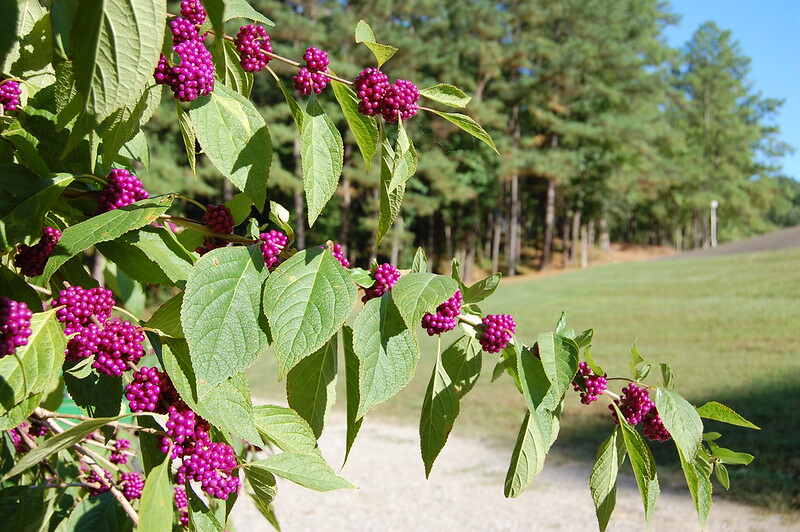
It’s easy to fill the spring and summer with bright colors from the flower-bearing plants that are available. Having a colorful fall landscape takes a bit more effort, but if you do your homework and select plants carefully, you can surround your home with eye-catching color from a variety of flowers, seed pods, or berries. Here are a few plants that you can depend on to punch up that autumn landscape.
1. Sasanqua Camellia

Sasanqua camellia is the quiet sister overshadowed by the more popular sister plant–Camellia. Always the afterthought—until you notice that the branches of the sasanqua have an unassuming grace, a delicacy, compared to the dense, stiff common camellia. The sasanqua blooms in the summer, and those flowers fade away as the frost comes.
As they die, we await the wonder of the flowers that bloom through autumn, sometimes into winter. Flowers may be cherry red, rose, shell pink, or white. The flowers appear for a short time, then the petals rain onto the ground as new flowers bloom. The carpet of petals surrounding the flower-laden shrub is an amazing example of nature’s beauty.
2. Red Clusterberry

The red cluster-berry is an evergreen with elliptical leaves, dark green on the top side and cream-colored underneath. Clusters of small white or pale-pink flowers, to the delight of bees, line up along the graceful branches at random in a free-flowing design in the spring. Bright red fruit, attractive to both humans and birds, contrasts beautifully with the leaves in the autumn and can last well into winter. Extremely versatile, it can be used as a groundcover or trained to grow flat against a wall or as a hedge.
3. Brandywine Viburnum nudum

White flowers in the spring become clusters of vivid pink and blueberries in the autumn when the glossy foliage turns to a dark maroon-red. The plant can be quite spectacular when it reaches six feet high. If you need to prune, do it soon after flowering; however, keep in mind that the more flower clusters, the more berries you’ll enjoy during autumn.
4. Virginia Creeper

The foliage of Virginia Creeper is a deep, rich green through the summer and turns fire-engine red in the autumn, becoming a stunning accent to your landscape. The red is set off by a profusion of blueberries. The plant “creeps” quickly in shade or partial shade, creating a fence of foliage and berries before you know it.
5. Beautyberry

The beautyberry produces a massive amount of purple berries in autumn after the lavender-pink lilac-like flowers from the summer have faded away. Besides adding an abundance of color to your autumn landscape, the berries attract birds, which give you more color. But here’s the thing: The birds apparently only eat them when they are desperate. The beautyberries remain on the bush long after the birds have feasted on other kinds of berries. The foliage adds more color with its deep green tinged with purple. You can plant the beautyberry under a tall shade tree or as a “relaxed” type of hedge along the perimeter of your yard.
6. Russian Sage

Russian sage, that is actually a native of Iran and India, infuses your landscape with dramatic violet-blue in the crystal-clear light of autumn. The bee-friendly flowers are set into aromatic leaves on a silver-white frame of branches. It is the only plant that exhibits a white skeleton of delicate branches. When Russian sage is planted in a group, the silhouette seems to glow in the subtler light of winter.
7. Calendulas

Also known as pot marigold, the shades of burnt yellow and orange help make the neutral fall foliage pop. The flowers provide color that blooms from autumn into the spring, particularly in warm southern winters. Calendulas thrive in full sun but will be fine with partial shade.
8. Ornamental Grasses

Ornamental grasses add color, texture, and movement to your landscape all year long, and they do that with little effort from you. Once established, water them during a drought, maybe cut them back in the spring. The following are some of the most popular grasses used for adding color to an autumn landscape and often throughout the winter.
- Pink Muhly Grass – Not as tall as most grasses, it usually reaches about three feet. Adds a breathtaking color that is mesmerizing as it sways in the breeze.
- Japanese Blood Grass – A slow-growing grass that is red all year and most intense hue of red in the autumn.
- New Zealand Flax – Not technically a grass, but is often used and acts as one. The beauty lies in the array of colors with bronze and purple becoming most prominent in the autumn.
Need help selecting different plants for your landscape? Talk with one of your local landscaping experts to help you design your best yard.
Main Image Credit: Pxhere





